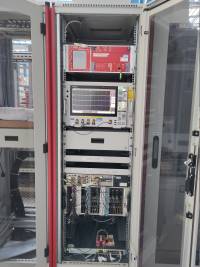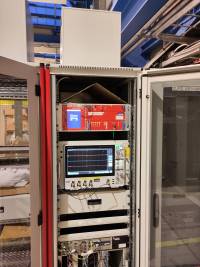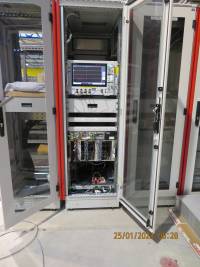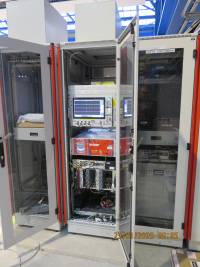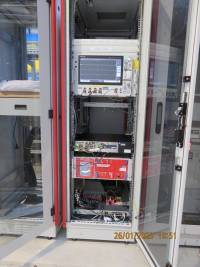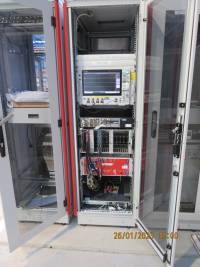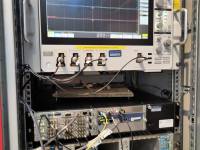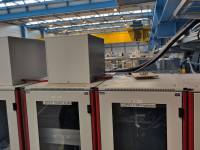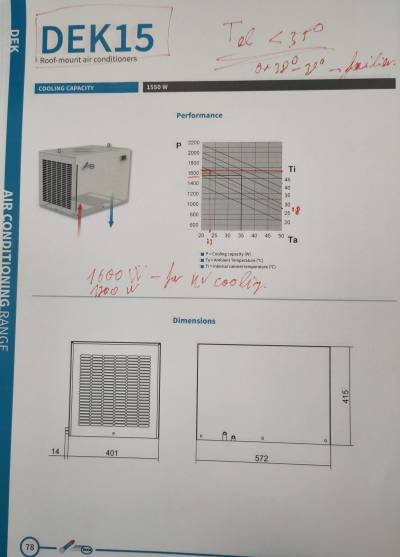Wiki
User Tools
Sidebar
Table of Contents
Improving the cooling of the rack with the BLM electronics
Task: In the last few summers were hot leading to higher temperatures at the ESR roof, which led to temperatures in the BLM electronic rack above 35 C. Temperatures close to 40 C may lead to electronics Failure. For instance all CAEN products are rated to operate up to 40 C .
Electronics Rack cooling
There is a air-condition unit installed on the top of the electronics rack. The unit model number is: TEXA ~DEK15BT0B, manual C17000199 describes the thermostat. The manufacturer recommends to set it to 30 C. If the temperature goes 2 K above the set point the unit will be engaged. One user is expected to set the temperature, hysteresis and if the evaporator fan should be always on/off/auto.
Optimizing the Electronic rack cooling
In the experiments described bellow the following tasks were accomplished:
- Determine the optimum configuration to reach the lowest rack temperature
- Determine the heat sources in order of significance
- Determine the cooling power needed to control the rack temperature
A RPi with a temperature sensor is used to monitor the temperature in the rack bellow the NIM crate positioned at the bottom. Here is the starting configuration:
- All electronics off, AC set to 25 C. Temperature in the rack 28.3 C. The switch and RPi are heating the rack.
- Switched on the NIM Crate. Now one can see the AC turning ON and OFF.
The period of oscillation changes. It is most likely related to outside temperature.
- Switched the Tek MSO44 scope. The temperature in the rack is 28.3 C but there are no more oscillation. Seems the AC is ON all the time
- Switched the CAEN HV, no HV ON. The temperature in the rack is 31 C
- Switched the DAQ electronics ON. The temperature in the rack got up to 34.5 C . During the night it went down to 33.6 C
- Added a triangle shape “roof”. The idea is to deflect the cod air to the side of the HV unit. This allows it to flow to the electronics below, but it cools less the HV. It creates an obstruction for the hot air to be sucked in the AC. The temperature raised by 0.5 C, it is now 35 C.
- Removed the paper “roof” and turned off the HV. The temperature stabilized at 31.7 C
- Removed the HV main frame, the temperature dropped from 31 C to 26 C
- Installed the HV under the scope, above the DAQ. Turned it on. The temperature stabilized at 31.5 C .
- There is a possibility to measure the HVCardsTemperature. The temperature is 30 C
- Installed the HV under the DAQ in place of the NIM bin. The temperature stabilized at 29.5 C. The HV card temperature is 29 C.
- Installed the NIM bin above the HV and the DAQ above the NIM bin. everything is on now. The temperature stabilized at 29.1 C .
- Open the front and back door. The temperature now is 24 C . The HV card temperature is 29 C. As this does not change I am not sure if the HV card reading is reliable.
- Christian set the AC set point to 23 C, hysteresis to +3 C. The temperature is now 27 C . The second sensor above the DAQ shows 27 C too.
- Used the CAEN Java tool. The fan speed was set to Med. The HV card temperature was 28 C for the 24 Ch card and 27 C for the 12 Ch cards.
I have measured the temperature above the DAQ too. Here is a photo of the second sensor read via an Arduino.
The temperature was the same for both sensors. Hence there is sufficient air mixing.
When increased the fan speed to High the temperature of the 24 ch card dropped to 27 C . Note that the temperature is available via the ssh tool too.
- Set the CAEN HV fan speed to High. The rack temperature set to 27.6 C . The HV card temperature is 28 C.
- Set the CAEN HV fan to Low speed. The temperature is now 28.5 C . The HV card temperature is 28 - 29 C .
Moved the second sensor outside of the rack. It is now measuring the hall temperature.
The outside temperature is 23 C.
- Leave the CAEN HV on, turn off the DAQ, scope and NIM crate. The temperature stabilized at 28 C
Observations:
- The maximum temperature in a close rack was reached with the paper roof on to of the HV: 35 C.
- The minimum temperature in a close rack was 26 C. Reached with the HV removed from the rack. Note that the AC set points is 25 C .
Therefore the AC has sufficient cooling power to take care of the system without the HV. The HV is the main heat load. Here is an estimate of the power generated from the electronics.
These are the parameters of the DEK15 and more powerful units DEK20 and DEK30.
Based on the estimate we need of order of 1600-1700 W cooling power. So lets use 1750 W for the search. A DEK20 at 35 C ambient temperature should be able to cool down to 30 C . This is a drop in replacement of a DEK15. It is 6 kg heavier than DEK15.
A DEK30 can cool bellow 20 C when operated at 35 C room temperature. But it requires more space and is 80 kg
As extreme case lest take 40 C hall temperature. The the DEK20 should stabilize the rack temperature just bellow 35 C . A DEK30 unit will no have problems keeping the temperature bellow 20 C even at 40 C ambient temperature.
Therefore a DEK20 is the minimum suitable choice for the rack cooling. A DEK30 is to be considered if additional BLM will be operated from the same rack.
Summary
- The main source of heat is the CAEN HV. The heat output of the rest is much lower.
- Placing the HV frame under the scope has the largest effect on the cooling efficiency in the rack.
- The optimum configuration is with the CAEN HV at the bottom. Speculation: there is a minimum space between the AC heat ducks and first heat generating unit above which the ordering of the units leads to small improvements.
- The cooling power needed to control the temperature in the rack is of order of 1700 W. I expect to add 4 more units, 2 LED drivers and 2 switching matrices. The will add of order of 40 W. Hence, I use 1750 W for the estimates
- A DEK15 unit operating in 35 C hall temperature will stabilize the rack temperature at around 40 C .
- A DEK20 unit operating in 35 C hall temperature will stabilize the rack temperature at around 30 C . (Note: this is a drop in replacement of DEK15, it adds 6 kg to the roof load)
- A DEK30 unit can keep the rack temperature bellow 20 C even in 35 C hall.

